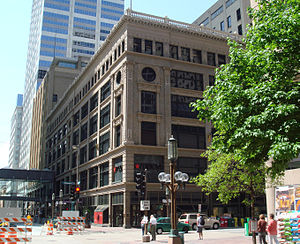- Dayton's
-
This article is about the defunct chain of department stores. For the former parent company formed by the 1969 merger with Hudson's, see Target Corporation.
Dayton's 
Industry Department store Fate Locations rebranded as Marshall Field's in 2001 Successor Marshall Field's (2001 – 2006)
Macy's (2006 – )Founded 1902 Defunct 2001 Headquarters Minneapolis, Minnesota Key people George Draper Dayton Parent Dayton-Hudson (later Target Corporation) Subsidiaries Target Minneapolis-based Dayton's was among the leading department stores in the United States for nearly a century[citation needed] after its founding in 1902 by George Draper Dayton. In 1969, the Detroit-based J.L. Hudson Company merged with the Dayton Corporation to form the Dayton-Hudson Corporation, adding 21 Michigan-based stores to the total. In 1990, the department store division of Dayton–Hudson (now Target Corporation) acquired Chicago-based Marshall Field's. Both Dayton's and Hudson's retained their individual store names until 2001, when they were united under the Marshall Field's nameplate. Prior to changing its name to Marshall Field's, Dayton's stores numbered 19, serving communities throughout the upper Midwest.
Dayton's was the parent of Target, opening the first Target in 1962 as the discount store version of Dayton's. Target quickly grew to become the majority of the company's business. In 2000, Dayton–Hudson was renamed Target Corporation. In 2004, Target finally divested their department store division to focus on discount retailing. May Company purchased the stores prior to its own acquisition by Federated Department Stores, which rebranded all the Marshall Field's stores as Macy's. Many Minnesotans have resisted the double name change, and continue to refer to "Dayton's" when speaking of the old stores in Southdale and Rosedale Center and Downtown Minneapolis and St. Paul.
Contents
History
Dayton's has roots in R.S. Goodfellow & Company, a dry goods business founded as Goodfellow and Eastman in 1878.[1] George Draper Dayton constructed a six-story building at Nicollet Avenue and Seventh Street in 1902 and convinced Goodfellow, then the fourth-largest department store in Minneapolis,[2] to become the tenant. The Goodfellow store opened June 24, 1902, and Reuben Simon Goodfellow retired shortly thereafter, selling his interest to Dayton, who financed and partnered with George Loudon and J.B. Mosher. By 1903, Dayton had bought out both partners and renamed the store Dayton's Dry Goods Company, which he ran with his son, Draper Dayton.[3] Between 1966 and 1986, Dayton's owned the B. Dalton bookstore chain.[4]
Timeline
- 1910: Name changes once again, to Dayton Company.
- 1949: Dayton's accepts several Cootie games on consignment from William "Herb" Schaper, a Milwaukee postman, fisherman, and toy maker. The game becomes a mega-hit with children and an icon of the baby boomer era.
- 1956: Dayton Company opens Southdale Center in Edina, Minnesota, the world's first fully enclosed two-level shopping center.
- 1962: Dayton's opens first Target store in Roseville, Minnesota
- 1963: Dayton's opens new store in downtown St. Paul as part of the city's "urban renewal" project.
- 1966: Dayton's opens first B. Dalton Bookseller in Edina, Minnesota
- 1969: Dayton's acquires J. L. Hudson Company, a dominant Michigan retailer with 21 stores. The combined firm is known as the Dayton–Hudson Corporation.
- 1978: The company acquires Mervyn's and becomes the 7th largest retailer in the United States.
- 1984: Dayton–Hudson sells off its John A. Brown Division in Oklahoma, and its Diamond's division in Arizona to Dillard's to focus more on midwest expansion.
- 1990: Marshall Field's is acquired by the Department Store Division of the Dayton–Hudson Corporation.
- 2000: Dayton–Hudson Corporation changes name to Target Corporation
- 2001: Much to the dismay of shoppers in Minneapolis/Saint Paul and Detroit, Dayton's and Hudson's are rebranded with the Marshall Field's nameplate, which has a higher national profile. Most product lines remain the same.
- 2004: Target and May Department Stores announce the sale of the Marshall Field's department store group, including the 62 stores serving communities in Illinois, Indiana, Michigan, Minnesota, North Dakota, Ohio, South Dakota and Wisconsin. Target sells off its Mervyns stores to a private investment fund. (Mervyns goes bankrupt in 2008.)
- 2005: Marshall Field's stores in Chicago, Minneapolis, Milwaukee and Detroit take the Macy's name, ending the run of Dayton's, Hudson's and Marshall Field's as its own unique, upscale midwestern department store community.
References
- ^ Atwater, p. 757
- ^ Rowley, p. 93
- ^ Rowley, p. 94
- ^ Laura J. Miller. Reluctant Capitalists: Bookselling and the Culture of Consumption. pp. 46–47. http://books.google.com/books?id=KxbZz3FPcH0C&pg=PA46&lpg=PA46&dq=%22b+dalton%22+%22Dayton+hudson&source=bl&ots=CsoecdkWQU&sig=Rg-ALrjS5kvKZsz1PIcfuNdJvyM&hl=en&ei=sHPWSou8H46-MJz1sd0D&sa=X&oi=book_result&ct=result&resnum=9&ved=0CCcQ6AEwCA#v=onepage&q=%22b%20dalton%22%20%22Dayton%20hudson&f=false. Retrieved 2009-10-12.
Further reading
- Atwater, Isaac (1893). History of the City of Minneapolis, Minnesota. Munsell.
- Rowley, Laura (2003). On Target. John Wiley and Sons. ISBN 0471250678
History of Marshall Field's Former Parent Companies: BATUS Inc. (1982-1990) | Target Corporation (1990-2004) | The May Department Stores Company (2004-2005) | Federated Department Stores, Inc. (2005-2006)
Associated Stores: Frederick & Nelson | The Crescent | Ivey's Store Conversions: Dayton's | Hudson's
Related Topics: Marshall Field | Marshall Field's Wholesale Store | Marshall Field and Company Building | Marshall Field and Company Store | FrangoCategories:- Defunct department stores of the United States
- Companies established in 1902
- Marshall Field's
- History of Minneapolis, Minnesota
- Stores converted to Marshall Fields
- Companies disestablished in 2001
Wikimedia Foundation. 2010.


